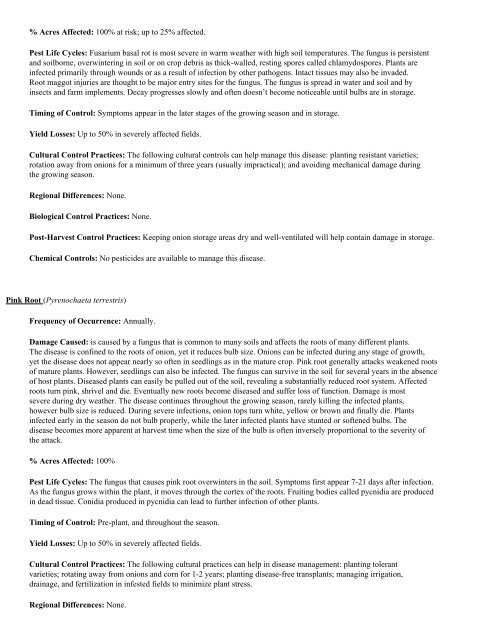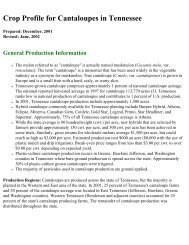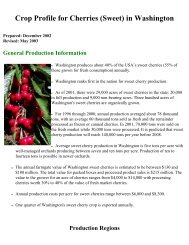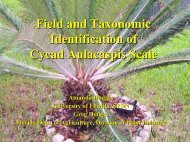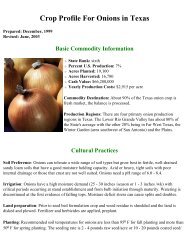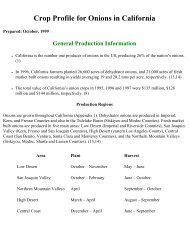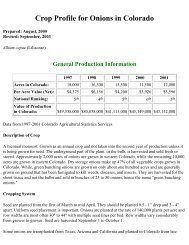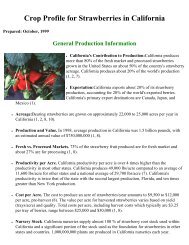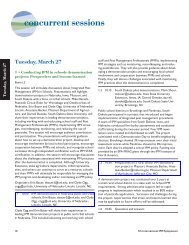Crop Profile for Onions in New York - Regional IPM Centers
Crop Profile for Onions in New York - Regional IPM Centers
Crop Profile for Onions in New York - Regional IPM Centers
Create successful ePaper yourself
Turn your PDF publications into a flip-book with our unique Google optimized e-Paper software.
% Acres Affected: 100% at risk; up to 25% affected.<br />
Pest Life Cycles: Fusarium basal rot is most severe <strong>in</strong> warm weather with high soil temperatures. The fungus is persistent<br />
and soilborne, overw<strong>in</strong>ter<strong>in</strong>g <strong>in</strong> soil or on crop debris as thick-walled, rest<strong>in</strong>g spores called chlamydospores. Plants are<br />
<strong>in</strong>fected primarily through wounds or as a result of <strong>in</strong>fection by other pathogens. Intact tissues may also be <strong>in</strong>vaded.<br />
Root maggot <strong>in</strong>juries are thought to be major entry sites <strong>for</strong> the fungus. The fungus is spread <strong>in</strong> water and soil and by<br />
<strong>in</strong>sects and farm implements. Decay progresses slowly and often doesn’t become noticeable until bulbs are <strong>in</strong> storage.<br />
Tim<strong>in</strong>g of Control: Symptoms appear <strong>in</strong> the later stages of the grow<strong>in</strong>g season and <strong>in</strong> storage.<br />
Yield Losses: Up to 50% <strong>in</strong> severely affected fields.<br />
Cultural Control Practices: The follow<strong>in</strong>g cultural controls can help manage this disease: plant<strong>in</strong>g resistant varieties;<br />
rotation away from onions <strong>for</strong> a m<strong>in</strong>imum of three years (usually impractical); and avoid<strong>in</strong>g mechanical damage dur<strong>in</strong>g<br />
the grow<strong>in</strong>g season.<br />
<strong>Regional</strong> Differences: None.<br />
Biological Control Practices: None.<br />
Post-Harvest Control Practices: Keep<strong>in</strong>g onion storage areas dry and well-ventilated will help conta<strong>in</strong> damage <strong>in</strong> storage.<br />
Chemical Controls: No pesticides are available to manage this disease.<br />
P<strong>in</strong>k Root (Pyrenochaeta terrestris)<br />
Frequency of Occurrence: Annually.<br />
Damage Caused: is caused by a fungus that is common to many soils and affects the roots of many different plants.<br />
The disease is conf<strong>in</strong>ed to the roots of onion, yet it reduces bulb size. <strong>Onions</strong> can be <strong>in</strong>fected dur<strong>in</strong>g any stage of growth,<br />
yet the disease does not appear nearly so often <strong>in</strong> seedl<strong>in</strong>gs as <strong>in</strong> the mature crop. P<strong>in</strong>k root generally attacks weakened roots<br />
of mature plants. However, seedl<strong>in</strong>gs can also be <strong>in</strong>fected. The fungus can survive <strong>in</strong> the soil <strong>for</strong> several years <strong>in</strong> the absence<br />
of host plants. Diseased plants can easily be pulled out of the soil, reveal<strong>in</strong>g a substantially reduced root system. Affected<br />
roots turn p<strong>in</strong>k, shrivel and die. Eventually new roots become diseased and suffer loss of function. Damage is most<br />
severe dur<strong>in</strong>g dry weather. The disease cont<strong>in</strong>ues throughout the grow<strong>in</strong>g season, rarely kill<strong>in</strong>g the <strong>in</strong>fected plants,<br />
however bulb size is reduced. Dur<strong>in</strong>g severe <strong>in</strong>fections, onion tops turn white, yellow or brown and f<strong>in</strong>ally die. Plants<br />
<strong>in</strong>fected early <strong>in</strong> the season do not bulb properly, while the later <strong>in</strong>fected plants have stunted or softened bulbs. The<br />
disease becomes more apparent at harvest time when the size of the bulb is often <strong>in</strong>versely proportional to the severity of<br />
the attack.<br />
% Acres Affected: 100%<br />
Pest Life Cycles: The fungus that causes p<strong>in</strong>k root overw<strong>in</strong>ters <strong>in</strong> the soil. Symptoms first appear 7-21 days after <strong>in</strong>fection.<br />
As the fungus grows with<strong>in</strong> the plant, it moves through the cortex of the roots. Fruit<strong>in</strong>g bodies called pycnidia are produced<br />
<strong>in</strong> dead tissue. Conidia produced <strong>in</strong> pycnidia can lead to further <strong>in</strong>fection of other plants.<br />
Tim<strong>in</strong>g of Control: Pre-plant, and throughout the season.<br />
Yield Losses: Up to 50% <strong>in</strong> severely affected fields.<br />
Cultural Control Practices: The follow<strong>in</strong>g cultural practices can help <strong>in</strong> disease management: plant<strong>in</strong>g tolerant<br />
varieties; rotat<strong>in</strong>g away from onions and corn <strong>for</strong> 1-2 years; plant<strong>in</strong>g disease-free transplants; manag<strong>in</strong>g irrigation,<br />
dra<strong>in</strong>age, and fertilization <strong>in</strong> <strong>in</strong>fested fields to m<strong>in</strong>imize plant stress.<br />
<strong>Regional</strong> Differences: None.


